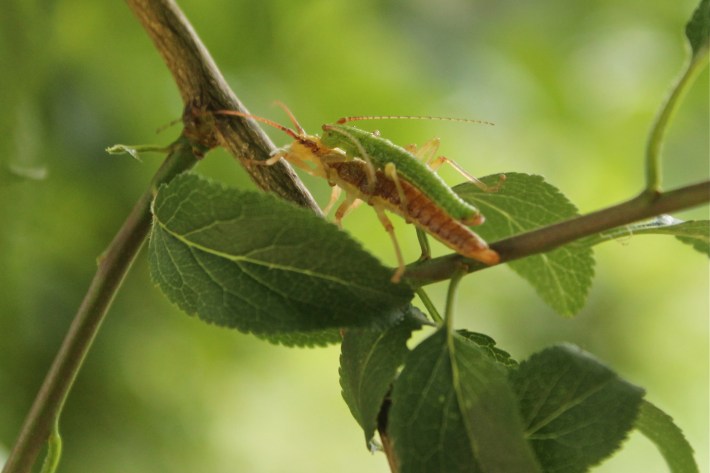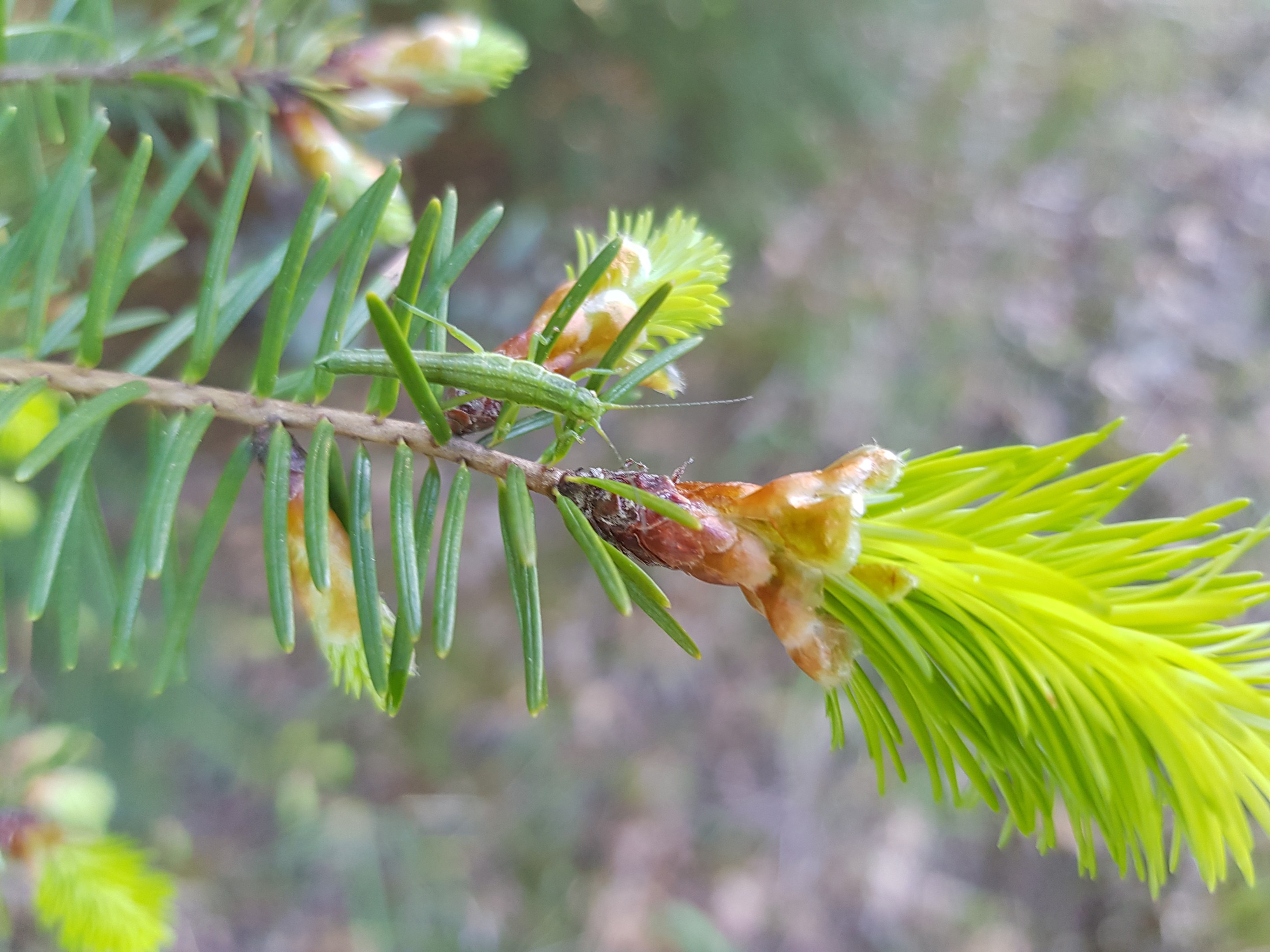Several species of wingless insects in the genus Timema are infamous for two things: looking like sticks and not having sex, which are totally unrelated traits. (Another genus of stick insects, Phryganistria, is infamous for coupling sessions that can last up to 79 days.) The sexless species of Timema reproduce via parthenogenesis, a process by which female animals give birth to all-female offspring. Males are not just uninvolved; they have essentially evolved out of existence.
Parthenogenesis, an ancient form of reproduction, first evolved with tiny, simple organisms. The process now happens mostly in tiny invertebrates but occasionally in larger vertebrates, the occurrence of which often makes headlines about "virgin births" in crocodiles and condors. But these stick insects are a rare example of an ancient species that have supposedly reproduced asexually for millions of years. Going this long without sex is a huge feat, evolutionarily speaking. Sex offers those who do it profound benefits, increasing genetic diversity and giving offspring the ability to adapt to new and unpredictable environments. And species that are totally, unrelentingly asexual are expected to eventually die off. So the fact that ancient asexuals like some Timema species have managed to thrive without sex for millions of years has long stumped scientists.
But sometimes the best explanation is the most obvious one. According to a paper published in the journal Proceedings of the Royal Society B, these ostensibly asexual stick insects have managed to dodge evolution by occasionally having sex. The allegations may seem shocking. But the stick insects join the ranks of several other ancient asexuals with surprisingly active sex lives. "I'm not so sure that ancient asexuals actually exist in any form," said Maurine Neiman, an evolutionary biologist at the University of Iowa who was not involved with the new paper. "I do think virtually all organisms are going to be more complicated than we presume them to be," she added.

Perhaps the most notorious ancient asexuals are microscopic creatures called bdelloid rotifers (the b is silent; you're on your own for the rest). The famed British biologist John Maynard Smith deemed the bdelloids "something of an evolutionary scandal," according to the paper "Ancient asexual scandals," which was published in the journal Trends in Ecology & Evolution and is sadly drier than its title suggests. The bdelloids appeared to have reproduced without any males for 80 million years without becoming an evolutionary dead end, in a flagrant exception to the ubiquity of sex. But in 2020, a group of scientists found evidence of genetic exchange and recombination in a handful of wild bdelloids that were incompatible with a strictly clonal life—opening the gates for investigations into other ancient asexuals' potentially sexual practices.
The biologist Susana Freitas originally studied asexuality in rock lizards until she joined the lab of Tanja Schwander, an evolutionary biologist at the University of Lausanne in Switzerland and an author of the paper. Schwander mentioned that some populations of asexual Timema species occasionally produce males, which opened up the question of sex, and the possibility of gene flow among asexual populations. "It was very unlikely that there was any type of gene flow in the population," Freitas said. "But we still wanted to check, because the males were there."
In 2017 and 2018, the researchers traveled to California to collect populations of four asexual Timema species in the wild. The tiny, evergreen needle–like insects are hard to collect by sight, so the researchers relied on a highly technical and efficient collecting process: "We put the net under the branch and then we hit it with a stick," Freitas said. Freitas also drew upon the lab's collections from prior years, gathering 192 females from the four known asexual species of Timema, T. genevievae, T. shepardi, T. monikensis, and T. douglasi, and an equal number of females and males from a closely related sexual species, T. cristinae. And one prior collection had four rare males, which are smaller than the chubbier females, in a population of T. monikensis living near a "For Sale" sign (subsequently nicknamed the For Sale population.)
Using the insects they had collected, the researchers sequenced random pieces of DNA along the genome and compared the representative sequences in different individuals. This allowed the researchers to estimate the genetic distance between the individuals. In most cases of asexual populations, different genomic variations, or alleles, will be passed on together to offspring, unless there is a mutation. "But mutations are more or less rare," Freitas said, adding that it would be even rarer for the specific alleles they were measuring to be separated. In sexual populations, genetic recombination happens randomly along the genome, meaning the alleles are reshuffled and are not always passed on together.
When the researchers analyzed the DNA of the allegedly asexual For Sale population, the one with four males, they noticed something weird. The whole population had unusually high genetic variability. The alleles they expected to be linked were not linked, and a few individuals had clearly inherited different alleles for the same genomic markers. Together, these patterns indicated these particular insects were the product of only one thing: sex. "It's just the most simple explanation," Freitas said. These Timema species had been reproducing asexually for a very long time, with a few exceptions to renovate the genetic pool. "They would only need a bit of sex every once in a while to keep them going," Freitas said.

Just a whiff of sex has served the otherwise celibate Timema species well over the years. Aside from the genetic challenges, asexuality can be a much easier way to make more of your own kind. In areas with sparse populations, asexual animals never need to worry about finding a mate; they only need themselves. And besides, "sex itself can be very dangerous, not only with STDs but also exposing themselves to predators," Freitas offered. (When I asked if stick insects had STDs, Freitas said she did not know but clarified there is always bacteria passed from one individual to another during any mating session, stick-to-stick or otherwise.)
Asexuality can make it easier for a population to bounce back after a devastating event, which are common in Timema's California habitat. "They live in this fire-prone habitat where there's a lot of fires going on," Freitas said. Although these wildfires can lead to local extinctions, a single asexual female would be perfectly capable of restarting a population by herself.
Does having sex, even rarely, mean a famously asexual insect is no longer asexual? As the researchers see it, absolutely not. "The biology of any organism is complicated," Neiman said. "These lines we like to draw between categories, you know, let's say male or female, sex or asex, are probably to some extent arbitrary." Sexual reproduction is a spectrum that can be flexible on both ends. Freitas brought up the example of the spontaneous parthenogenesis recorded in the crocodile or condor, both species that otherwise exclusively reproduce sexually. Despite these rare occurrences, we would never describe these creatures as asexual, Freitas explained. "That doesn't make them sexual. It just makes them parthenogens that maybe could find a way of persisting through evolutionary times.'
And so this new paper reminds us of one of the golden rules of science and life: Assumptions can make asses of us all. "Without really comprehensive evaluation of the biology, ecology, and natural history of any presumably ancient asexual organism, we certainly cannot conclude that they're not having any sex," Neiman said. So if you happen upon a pair of asexual stick insects sticking it you know where, don't stare. They're renovating their genetic pool!






